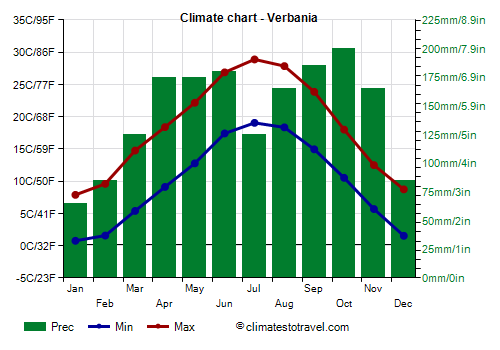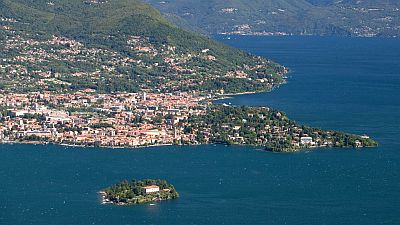Select units of measurement for the temperature and rainfall tables (metric or imperial).
Average weather, temperature, rainfall, sunshine hours

In Verbania, there is a
humid temperate climate. Winters are with relatively cold and damp. Summers are warm to hot, and are characterized by a good amount of sunshine, but also by quite frequent thunderstorms. Because of the influence of the lake, the climate of Verbania is a bit milder and rainier than in the Po Valley.
The city is located in northwestern Italy, on the Piedmontese shore of Lake Maggiore, at 215 meters (705 feet) above sea level, and is the capital of the province of Verbano-Cusio-Ossola. In front of the small peninsula of Verbania we find the Borromean islands, and to the west Gravellona Toce. To the north is the Val Grande National Park, with Mount Zeda, 2,156 meters (7,074 feet) high. To the southwest is the smaller Lake Orta.
Precipitation is abundant. Winter is the relatively driest season. In spring and autumn, when Atlantic depressions pass over the area, the rains are abundant because the southern currents are forced to climb the Alpine foothills. In late spring and summer, thunderstorms are quite frequent (and sometimes intense) in the afternoon and evening.
During the most intense waves of bad weather, which occur in autumn (but sometimes also in spring), the lake may overflow, flooding the coastal towns.
In the cold half of the year, the
wind on Lake Maggiore is often weak or non-existent, except when the
favonio (or
föhn) blows, the warm and dry wind that comes down from the Alps and is able to bring clear skies and very good visibility. During the warm half of the year, under conditions of good weather, the wind is weak or moderate and follows the
breeze regime (and it is more intense in late spring than in midsummer): during the warmest hours, it blows from the plains to the mountains (the breeze from the south, called "inverna"), while after sunset and at night, it blows from the mountains to the plains (the "tramontana", the breeze from the north). The breeze is appreciated by lovers of sailing, surfing and windsurfing.
 Winter
Winter, from December to February, is pretty cold, but it's not as cold as the Po valley because of the mitigating influence of the lake. Also, fog is very rare here.
Snow generally falls at least once every year, however, it is not as abundant as in the surrounding hills, moreover, it tends to melt soon enough, because it occurs with the south wind. On average, 20 cm (8 in) of snow fall per year.
Typically, the snow depth reaches 30-35 cm (12-13.5 in) during the heaviest snowfalls, although in the exceptional snowfall of January 1985, the snow reached 95 cm (37.5 in) in height.
We can not exclude very cold periods, with night frosts, and temperatures around 0 °C (32 °F) even during the day. The temperature dropped to -8.5 °C (16.5 °F) in February 1956 and to -7.5 °C (18.5 °F) in February 2012.
Summer, from June to August, is warm to hot, and often sunny in the morning. The heat is less intense than in the Po Valley, in addition, there is a little more wind because of the lake breeze. Sometimes, an Atlantic front, able to bring some cool and rainy days, can affect this area; more often, thunderstorms can break out in the afternoon and evening.
However, we can not exclude some particularly hot days, with highs around 35 °C (95 °F). In August 2003, the temperature reached 37.5 °C (99.5 °F).
Best Time
The
best times to visit Verbania are spring and early summer, in particular, from mid-April to mid-June. September is also a good month. However, you have to take into account some rainy days in both periods.
In summer, temperatures can be hot, although many days are acceptable, especially in June. You must take into account, in summer and in May, afternoon or evening thunderstorms.
Verbania - Climate data
In Verbania, the
average temperature of the coldest month (January) is of
4.3 °C, that of the warmest month (July) is of
24 °C. Here are the average temperatures.
Verbania - Average temperatures (2006-2020) |
| Month | Min | Max | Mean |
|---|
| January | 0.8 | 7.9 | 4.3 |
|---|
| February | 1.6 | 9.6 | 5.6 |
|---|
| March | 5.4 | 14.8 | 10.1 |
|---|
| April | 9.1 | 18.4 | 13.7 |
|---|
| May | 12.8 | 22.2 | 17.5 |
|---|
| June | 17.4 | 26.9 | 22.1 |
|---|
| July | 19 | 28.9 | 24 |
|---|
| August | 18.3 | 27.8 | 23.1 |
|---|
| September | 14.9 | 23.9 | 19.4 |
|---|
| October | 10.5 | 18 | 14.3 |
|---|
| November | 5.7 | 12.5 | 9.1 |
|---|
| December | 1.5 | 8.7 | 5.1 |
|---|
| Year | 9.8 | 18.3 | 14.05 |
|---|
amounts to
1725 millimeters per year: it is therefore abundant. It ranges from
65 millimeters in the driest month (January) to
200 millimeters in the wettest one (October). Here is the average precipitation.
Verbania - Average precipitation| Month | Days |
|---|
| January | 65 | 8 |
|---|
| February | 85 | 6 |
|---|
| March | 125 | 8 |
|---|
| April | 175 | 9 |
|---|
| May | 175 | 12 |
|---|
| June | 180 | 10 |
|---|
| July | 125 | 8 |
|---|
| August | 165 | 10 |
|---|
| September | 185 | 8 |
|---|
| October | 200 | 8 |
|---|
| November | 165 | 8 |
|---|
| December | 85 | 9 |
|---|
| Year | 1725 | 104 |
|---|
There are on average around 2030
sunshine hours per year. Here are the average hours of sunshine per day.
Verbania - Sunshine hours| Month | Average | Total |
|---|
| January | 4 | 120 |
|---|
| February | 4.5 | 125 |
|---|
| March | 4.5 | 140 |
|---|
| April | 6 | 175 |
|---|
| May | 6 | 190 |
|---|
| June | 8 | 235 |
|---|
| July | 8.5 | 255 |
|---|
| August | 7 | 220 |
|---|
| September | 6 | 185 |
|---|
| October | 4.5 | 145 |
|---|
| November | 4 | 120 |
|---|
| December | 4 | 120 |
|---|
| Year | 5.6 | 2030 |
|---|